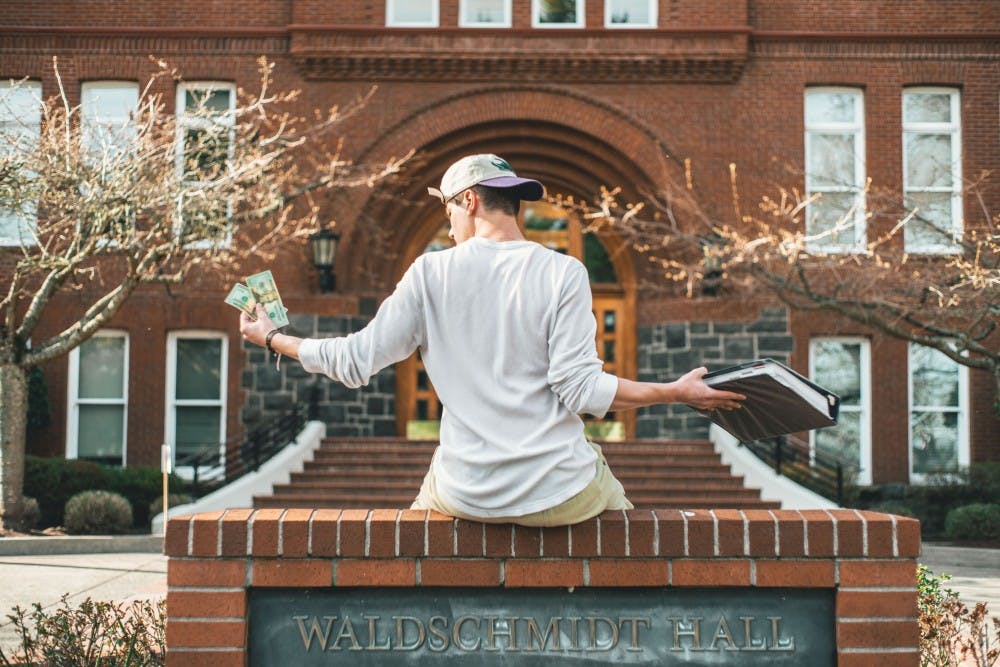It is no secret that the cost of going to college has been climbing dramatically. The high cost of college is an epidemic that has spread across the entire country, reaching universities all over the U.S., including the University of Portland.
With $1,916, you could buy 912 medium cups of black coffee at Starbucks. Or 239 medium hand-tossed pizzas from Domino’s. Or 1,916 notebooks from the dollar store. Next year, however, $1,916 is how much more UP students will pay in tuition for the 2019-20 school year, a 4.2 percent increase from last year (2018-19).
It's not just tuition increasing each year though; room and board will take a price hike next year, as well. The meal plan with the standard room and board set up (a double or triple at full occupancy), will go up 3.9 percent. This makes the minimum tuition with room and board a total of $60,824 for next year.
The reasons tuition increases range far and wide. The Beacon has gathered information from the Financial Aid Office, Institutional Research, the Bureau of Labor Statistics and others to make sense of all the hidden variables behind tuition increases. These include discount rates, inflation and other increasing costs colleges face.
The estimated total price for the 2018-19 academic year reported by the National Center for Education Statistics at UP was $62,200. To draw some comparison, Gonzaga was $59,795 and our sister school, Notre Dame, was $71,801.
But few UP students will actually pay that full price. UP and many other private institutions post a discount rate. This estimates how much the first year of school will cost on average for freshmen once institutional scholarships and grants are included. UP’s discount rate for this year was estimated to be 45.5 percent, according to Vice President of Financial Affairs Alan Timmins. This means that UP freshmen on average will pay 45.5 percent less than the listed price.
Ninety-nine percent of students at UP receive scholarships or grants to offset tuition, according to the National Center for Education Statistics. The net prices of tuition alone for the 2018-19 school year after financial aid were $33,327 at UP, $34,085 at Gonzaga and $27,453 at Notre Dame.
Source: University of Portland Financial Aid Office
Below is a layout of prices for room and board per meal plan from the 2016-17 school year to 2019-20.
Source: University of Portland Financial Aid Office
Need-based financial aid makes it so that few students at UP actually pay the full price of tuition, and that aid has been increasing alongside tuition, too. However, need-based aid is not the only reason UP students may not pay full price. UP also provides merit-based scholarships.
Below is a graph of how the discount rate has increased over the past five years.
Source: University of Portland Financial Aid Office
The discount rate increased by 1.5 percent in five years, which seems like a small number compared to how much tuition has gone up in the same time frame. Take this for example: If tuition is $40,000 one year, and the discount rate is 40 percent, then the total discount is $16,000. If tuition in the following year is $42,000, and the discount rate was still 40 percent, the discount would increase to $16,800. As tuition rises, so does the amount of money discounted.
However, students with scholarships are confronted with a distressing realization for their next year at UP: While tuition continues to rise, their scholarship amount does not. When that acceptance letter came in the mail, and students read their scholarships out loud to their family, it was easy to forget that the scholarship is over four years. When tuition goes up next year, scholarships do not rise to cover the increases. This makes school more expensive than their first year.
For example, a new student receives the Presidential scholarship from UP. The scholarship is $100,000 over four years. That’s $25,000 a year. So, if tuition for their first year was $45,000, they would pay $20,000 out of their own pocket (or through loans or other forms of aid). The next year when tuition rises $2,000, they still only receive $25,000, so now they are paying $2,000 more out of pocket. This is a problem that all UP students with scholarships will face.
Along with the normal activities of running a university like UP, there are other outside factors influencing tuition. One of these is inflation, which is the way that money becomes worth less as time goes on. For example, a dollar today will likely be worth less than its original value two years from now. This translates into higher prices over time to compensate, whether that be in the candy bar you bought last week or in your education.
Inflation is hard to measure, but the government Bureau of Labor Statistics has found a way to do it. They track the prices of goods that people would buy on a day-to-day basis throughout the months of the year and see how much the prices have gone up. The number they eventually work out is called the Consumer Price Index for all Urban Consumers (the CPI-U). If the prices are rising (like they have been for decades), it is a sign of inflation.
Below is a comparison of how tuition has been increasing in comparison to inflation. This is shown in percentage increases each year. The data shows that the cost of attending UP has increased far above the CPI-U.
Source: University of Portland Financial Aid Office, Bureau of Labor Statistics Historical CPI-U
Tuition has increased 4-5 percent each year as shown in the graph, fair higher than the inflation rate, which has ranged between 0.5 percent and 3 percent.
Since the 2014-15 academic year, inflation has gone up 6.1 percent, where tuition has gone up nearly 19 percent in the same time. So this begs the question, why the cost of college is going up so much faster than the cost of most other things? The answer is not really clear, but there are several factors.
Salaries and wages have been climbing along with housing costs. It is also important to note that health care costs have been rising all over the country, and employers need to account for the rising costs for staff and professors.
Another rising cost to consider is the increase in students attending college since the mid 1900’s, which results in a need for more accommodations and resources.
Other potential reasons include the rises in student aid available. Marketplace, a source focused on economic news, reported that former U.S. Secretary of Education William Bennett theorized that it was federal financial aid that allowed colleges to increase their tuition. However, this theory has proven hard to confirm, according to Marketplace.
Rising costs have also been attributed to competition between colleges. Whether it be on the front of science equipment or marketing tools in general, universities want to provide students with high-quality equipment and resources. Marketplace also reported that this has taken form in an “arms race” for newer, fancier buildings and equipment.
The bottom line is that, with the current inflation rate, the dollar is worth less every day. Tuition is rising. And this makes the decision between attending college or not even more difficult. Evidence shows it still pays off to go to school. The Atlantic reported in 2015 that those who had an undergraduate degree earned 80 percent more than those who did not pursue or complete a four-year degree.
“The upshot is that it's not perfectly clear, but for most people, it totally pays if they get a college education,” said William Barnes, associate professor of economics. “We live in a society where credentials matter, big time. A college degree, while expensive, is a good investment.”
Austin De Dios is a reporter for The Beacon. He can be reached at dedios22@up.edu.








